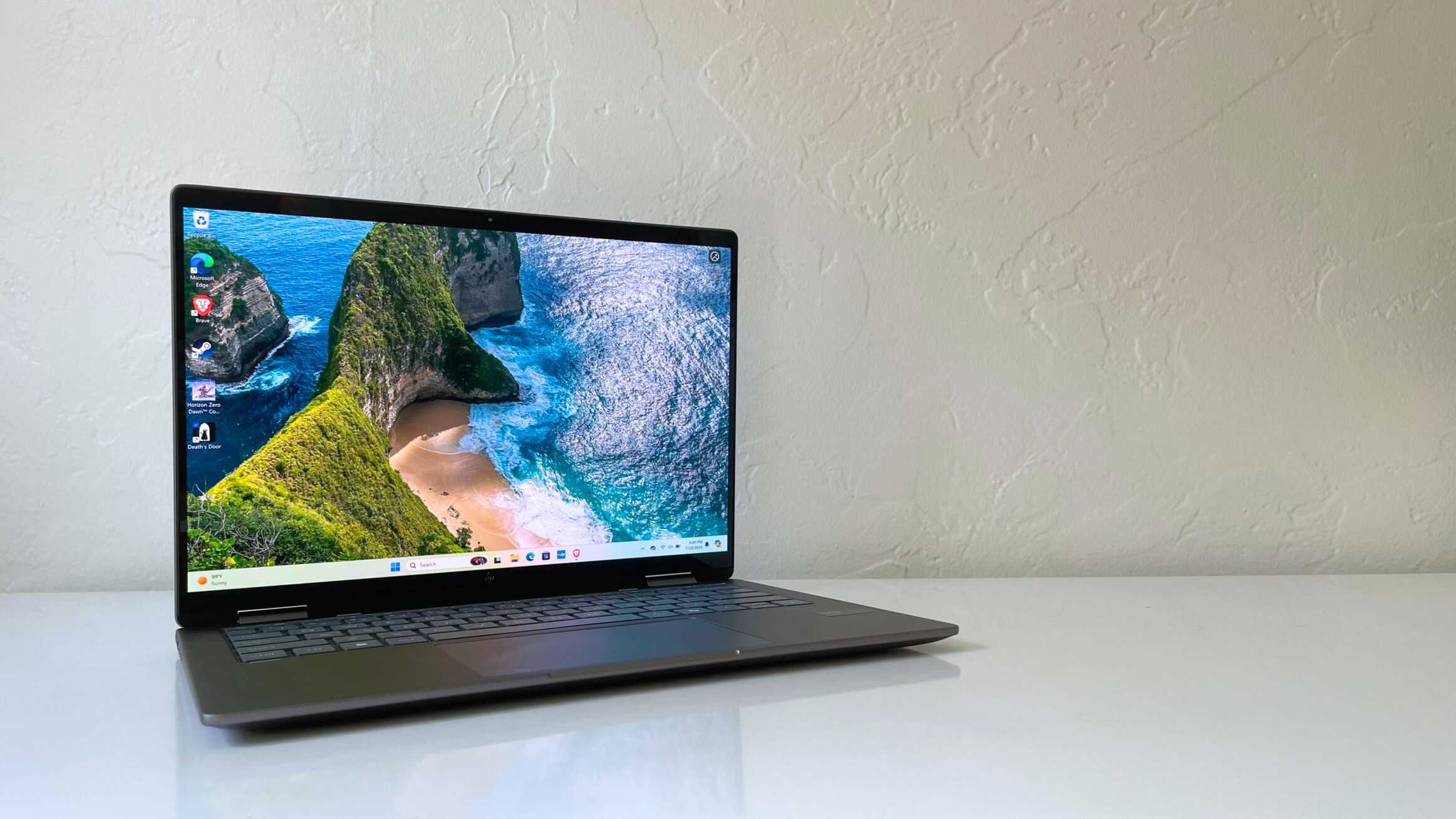
Despite its strengths, the HP Envy x360 2-in-1 struggles to keep up in all the ways that matter most.
The HP Envy x360 2-in-1 is a sleek mainstream laptop sporting a fairly standard metallic gray design. It feels good to type on and features speakers that are hard not to like. However, the Envy leaves something to be desired when it comes to performance. If you’re in the market for a compact mainstream laptop, you should know a few things before shelling out over $1,000 on the HP Envy x360 2-in-1.
After using the Envy for a week, I got a pretty thorough idea of where it shines and where it struggles. Here’s an in-depth look at my experience testing the HP Envy x360 2-in-1 and the eye-opening results of our benchmark tests.
HP Envy x360 2-in-1: Specs (as reviewed)
HP Envy x360 2-in-1: Price and configurations
The HP Envy x360 2-in-1 is available in several customizable configurations starting at $949. HP offers Intel and AMD CPUs, including the Intel Core Ultra 5 125U, Intel Core Ultra 7 155U, AMD Ryzen 5 8640HS, and AMD Ryzen 7 8840HS. The two base CPUs are the Intel Core Ultra 5 125U and the AMD Ryzen 5 8640HS. The other CPU options cost extra ($120 for the Intel Core Ultra 7 155U and $150 for the AMD Ryzen 7 8840HS).
You can also customize the display, RAM, and storage in the HP Envy. The base configuration with either base CPU includes 16GB of RAM and 512GB of storage. You can bump your specs up to 32GB of RAM or 2TB of storage, but it will cost extra.
As for the display, the Envy comes with a 1920x1200 IPS display with a maximum of 300 nits of brightness. You can upgrade to a slightly brighter 1920x1200 IPS panel for $100 extra or a 2880x1800 OLED panel for $150 extra. Our review unit includes the OLED display.
HP Envy x360 2-in-1: Design
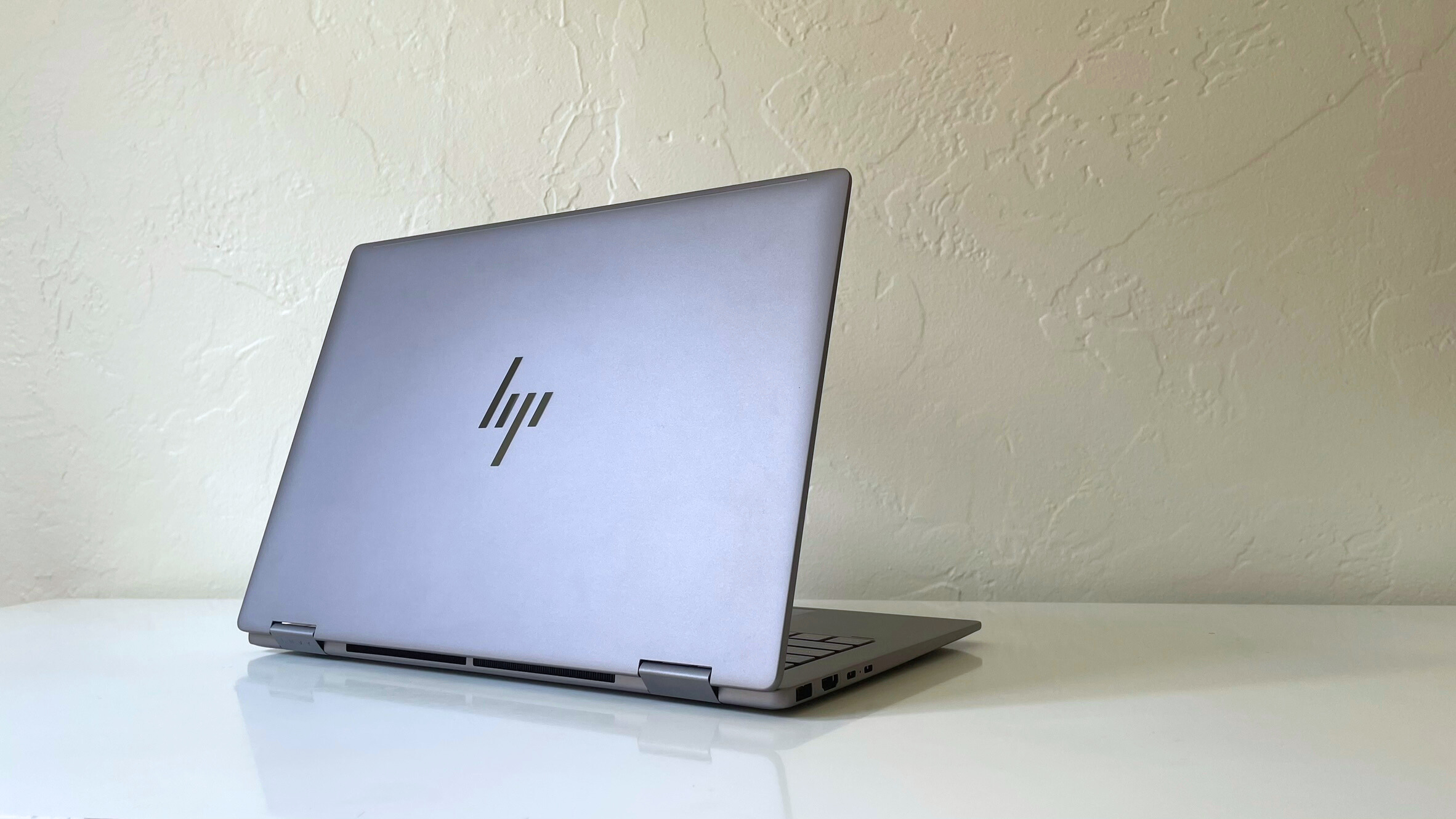
The HP Envy x360 2-in-1 features a simple, straightforward design. It’s wrapped in an aluminum chassis made with 50% recycled metal and comes in two colors: Glacier Silver or Meteor Silver (light and dark silver). Our review unit is in the Meteor Silver colorway, a dark metallic gray with a gray plastic keyboard deck.
The keyboard has a full set of function keys pre-assigned to various media tasks like screen brightness or volume. There’s also a dedicated Copilot key in the bottom right corner.
The one quirk of this keyboard deck is the power button placement. It’s shaped exactly like a function row key and placed between the screenshot key and delete key rather than isolated in the corner of the keyboard deck. It’s not necessarily a bad spot for the power button, though. Just be careful you don’t accidentally hit it when reaching for the delete key.
The Envy has an 89% screen-to-body ratio with thicker bezels on the top and bottom edges of the display than on the sides (the bezels are not the same width all the way around). Along the display’s top edge, there’s a physical, built-in privacy shutter for the webcam.
HP Envy x360 2-in-1: Ports
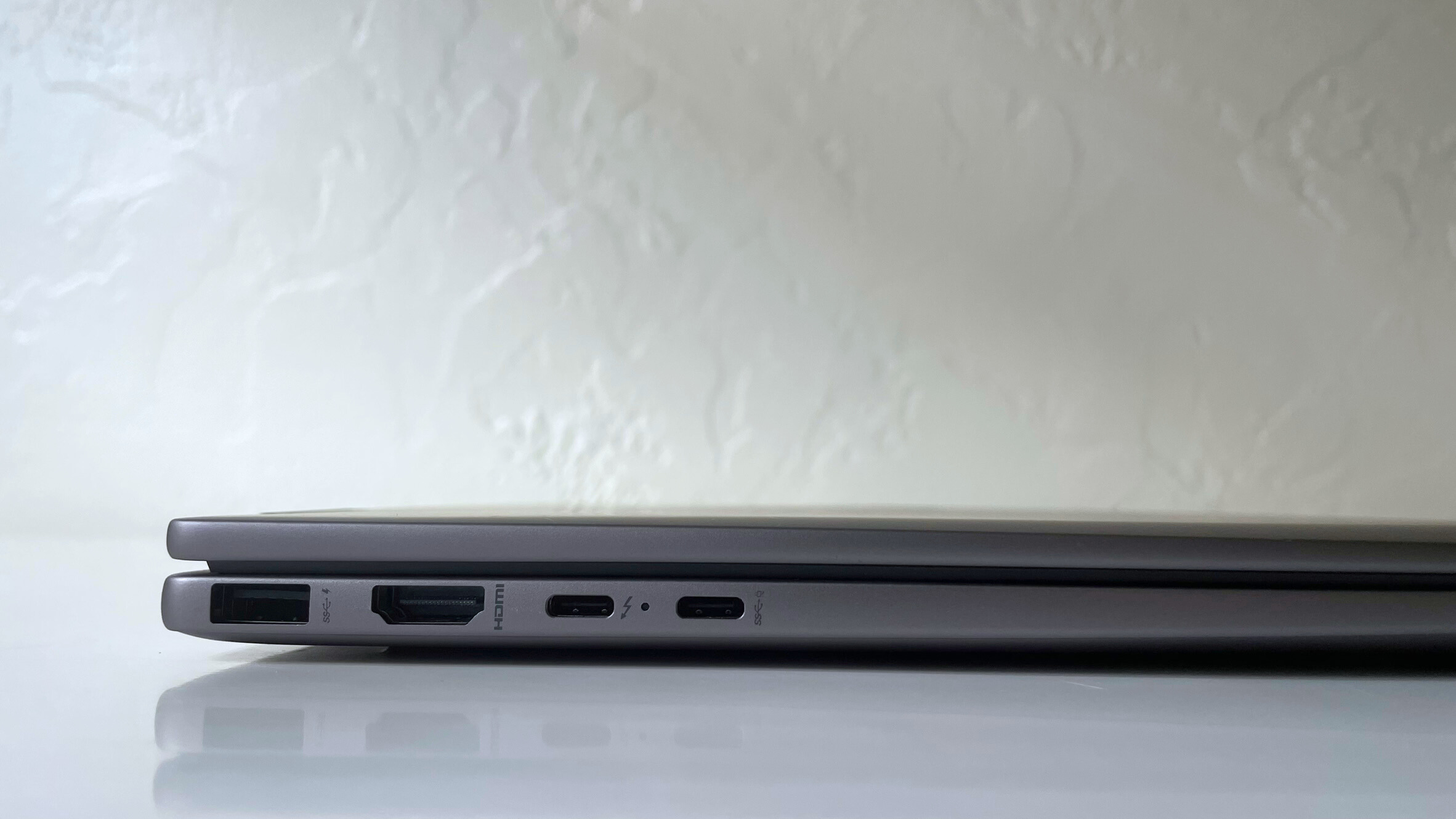
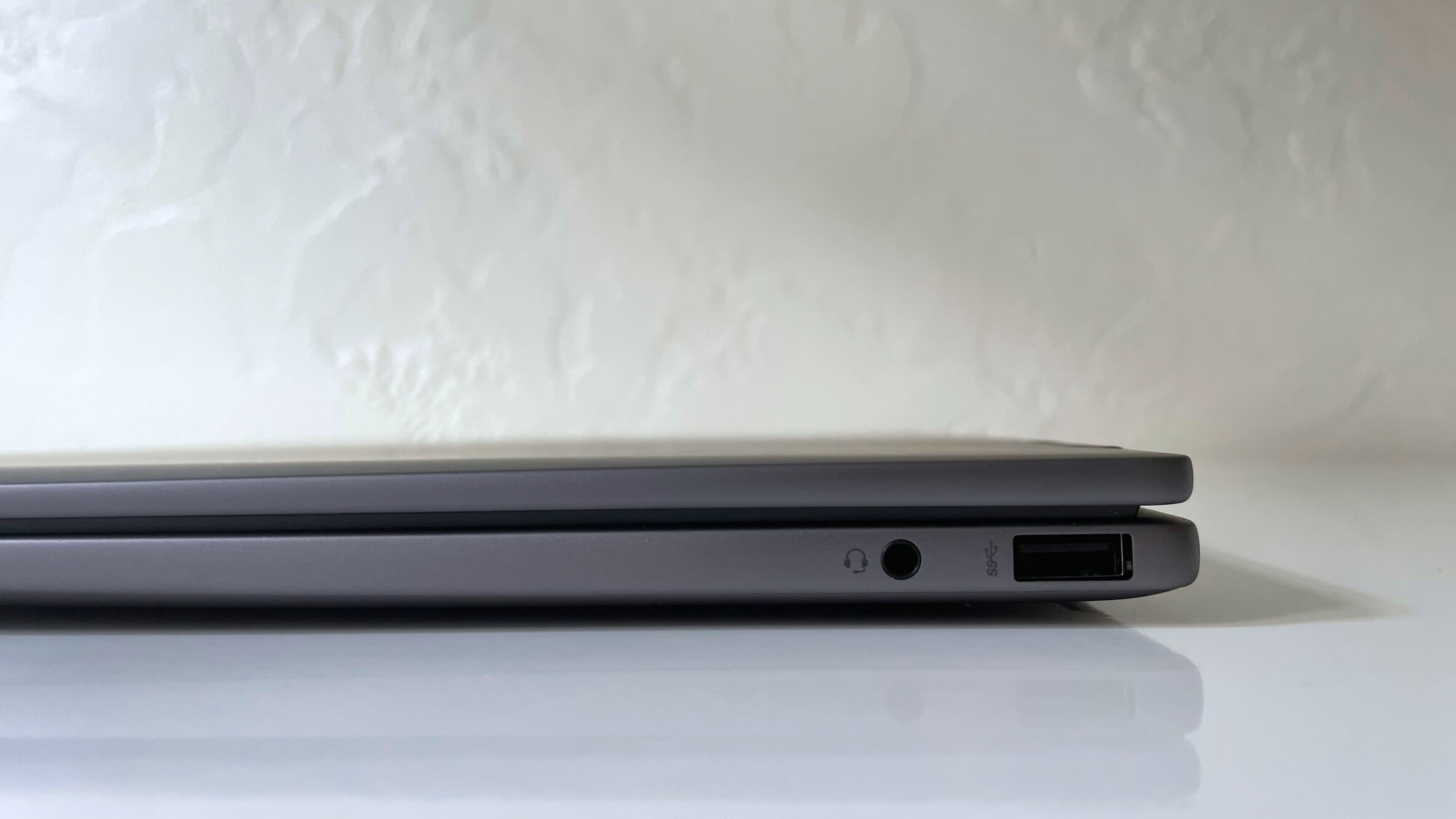
The HP Envy x360 2-in-1 has a fairly standard selection of ports. On the right edge, there is one USB Type-A port and a headphone jack. On the left side, you’ll find a second USB Type-A port, an HDMI port, and two USB Type-C ports (one is for charging).
There were plenty of ports for the accessories I used while testing the HP Envy. If you need more ports, though, you can add one of the best USB Type-C hubs to your desk setup. Alternatively, if you frequently connect your laptop to an external monitor, a docking station might be a more robust alternative to a USB hub.
HP Envy x360 2-in-1: Display
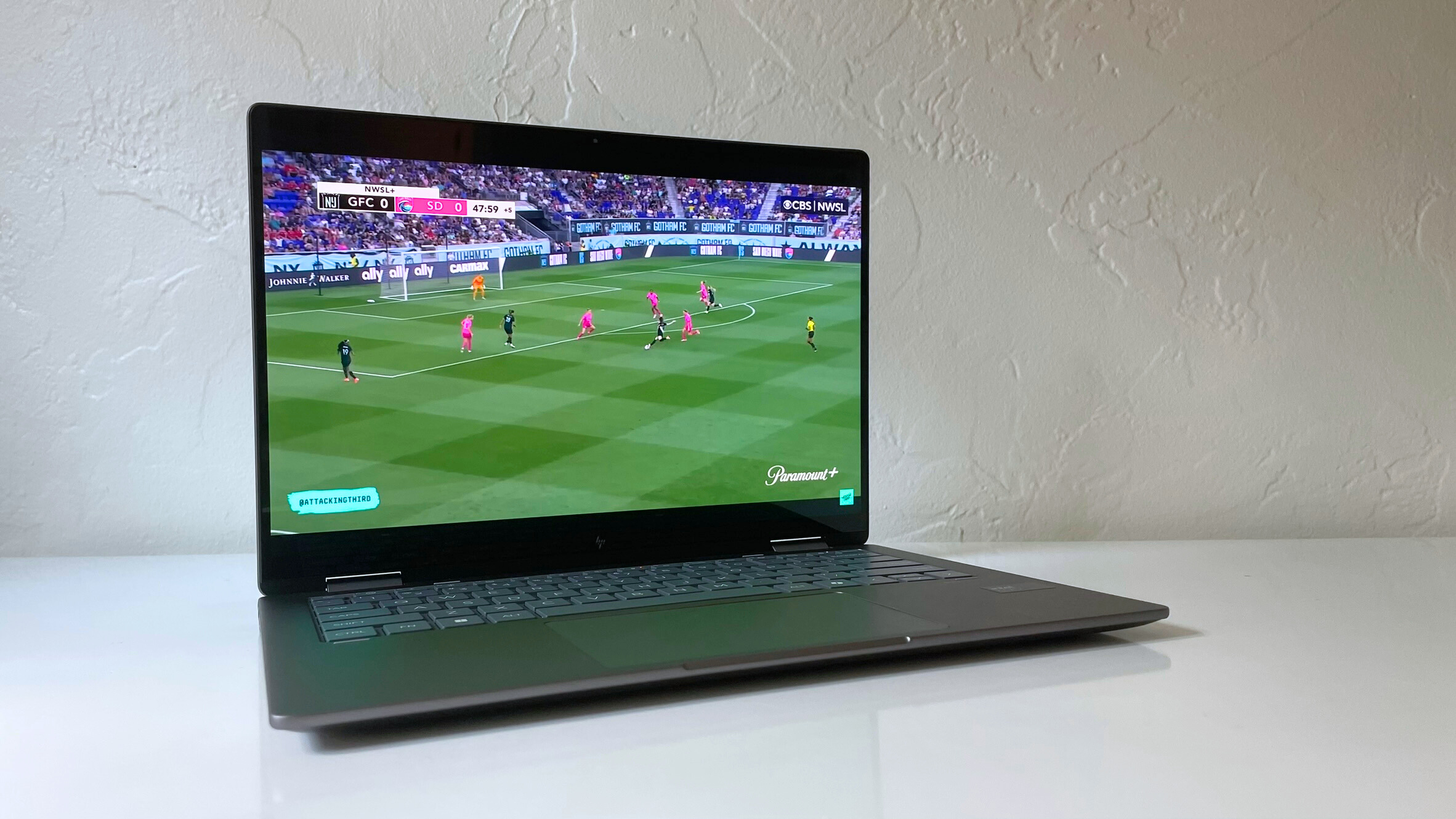
The HP Envy’s display is one of its strong points, but you’ll have to pay a premium to upgrade to the best display configuration. Our review unit includes a 2K 2880x1800 OLED touch display, which costs an additional $150. The standard display in the base configuration is a 1920x1200 IPS display.
The main differences between these two configurations are max brightness and pixel density. The IPS panel has a lower max brightness of 300 nits (compared to 500 nits on the OLED panel), and since it has a lower resolution, it has a lower pixel density. That means the OLED display looks sharper despite having the same screen size.
The OLED panel performed well in our display tests. It covered 136% of the DCI-P3 color gamut, averaged 368 nits of brightness in SDR, and maxed out at 572 nits of brightness in HDR. It outscored the HP Spectre x360 14 and Lenovo Slim 7i Gen 9 on the color gamut test but fell behind both on average brightness and came in just 13 points shy of the Lenovo Slim 7i on max brightness.
HP Envy x360 2-in-1: Keyboard and touchpad
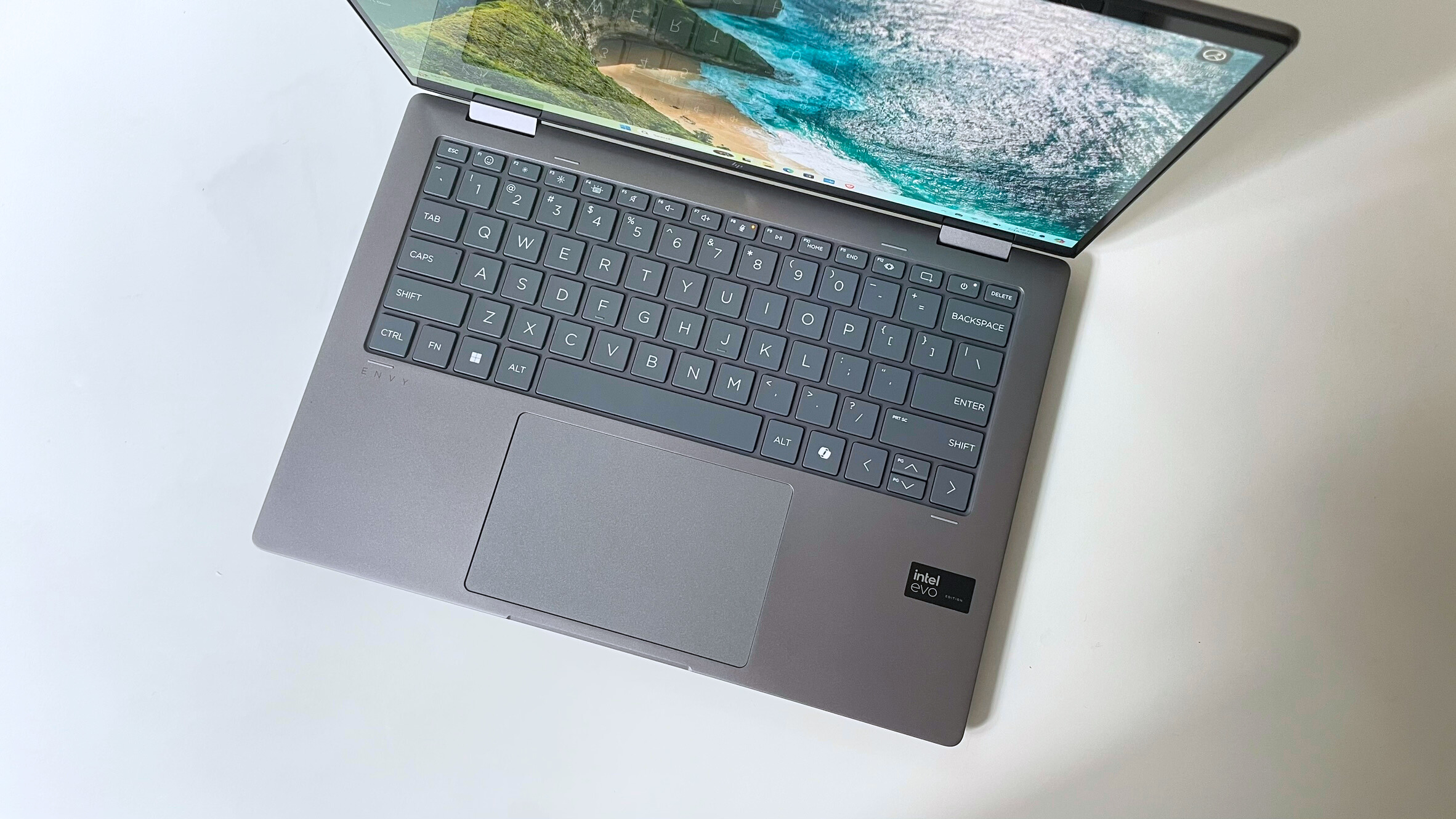
During my testing, I found the HP Envy’s keyboard comfortable and satisfying to type on. It features a fairly standard design with dark gray keycaps and white lettering. There’s a thin function row along the top edge, with each function key pre-assigned to a media function, such as screen brightness or volume. The keyboard also features white backlighting, which you can adjust or toggle off with the F4 key.
On the Monkeytype typing test, I scored 101 words per minute with 99 percent accuracy on the HP Envy, which is well above my laptop average of 90 wpm with 97 percent accuracy.
The touchpad is also solid. It measures 3.3 x 5.1 inches and has a smooth, nearly matte texture. I found it comfortable and responsive during my testing. Clicking on it offers some tactile feedback, but it isn’t loud.
HP Envy x360 2-in-1: Audio
The speakers on the HP Envy x360 2-in-1 are reasonably good. They’re not quite as loud as some other laptops I’ve tested, but they’re still more than loud enough for just about anything you’d want to listen to, such as games, music, and movies. The sound quality is also solid, with a decent balance between bass, mids, and highs.
Khalid’s “Saturday Nights” sounded clear and smooth, with a pretty balanced sound profile that wasn’t too heavy or weak on the bass. “Free If We Want It” by Nothing But Thieves sounded especially good, coming through the HP Envy’s speakers with a well-rounded tone and excellent detail throughout, particularly with lead singer Conor Mason’s vocals.
HP Envy x360 2-in-1: Gaming and graphics
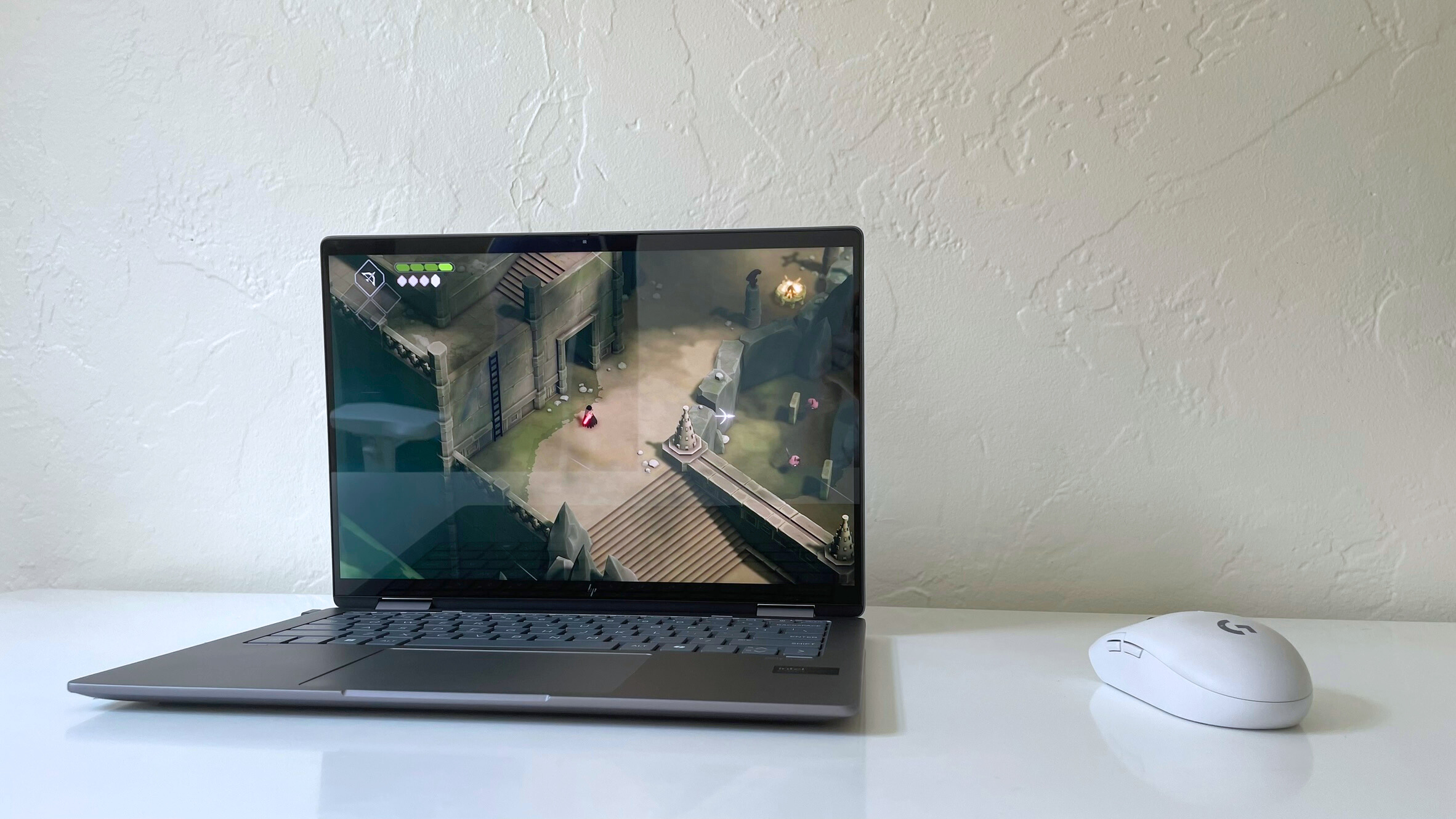
The HP Envy x360 2-in-1 isn’t a gaming laptop, and it shows. It can manage low-spec games but struggles to surpass 25 frames per second on anything more. You can still achieve a playable experience with low graphics settings in indies and older games, but medium and high graphics are not feasible with the HP Envy’s integrated GPU.
Of course, most mainstream laptops don’t have a discrete GPU (a dedicated GPU separate from the CPU). However, the HP Envy fell behind in our graphics tests even compared to other mainstream laptops.
The HP Envy scored 4616 on the 3DMark FireStrike test and averaged only 25 fps in Sid Meier’s Civilization VI: Gathering Storm. In comparison, the HP Spectre x360 14 scored 36 fps, and the Lenovo Slim 7i Gen 9 averaged an admirable 41 fps in Sid Meier’s Civilization VI, and the Slim 7i scored a whopping 8455 on the 3DMark FireStrike test, nearly double the HP Envy’s score.
I also noticed the HP Envy’s lackluster gaming performance in my hands-on testing. I played Horizon: Zero Dawn and Death’s Door on the Envy. Horizon: Zero Dawn is several years old but still quite resource-intensive. I was able to run it on the Envy and managed a fairly playable experience on low graphics settings, but I noticed quite a few dropped frames and only averaged 22 frames per second.
Death’s Door is a lightweight indie title but can be fast-paced and features saturated, colorful graphics. The graphics on the HP Envy’s OLED display looked fairly good, but it struggled to keep up once I started moving around. The default graphics settings were 2880x1800 and 60 fps, but I was definitely not getting 60 fps.
I had to lower the frame rate setting to 30 fps to get a playable experience. However, it was better overall when I dropped the resolution down a level, too (which somewhat defeats the purpose of having a high-resolution OLED display).
HP Envy x360 2-in-1: Performance
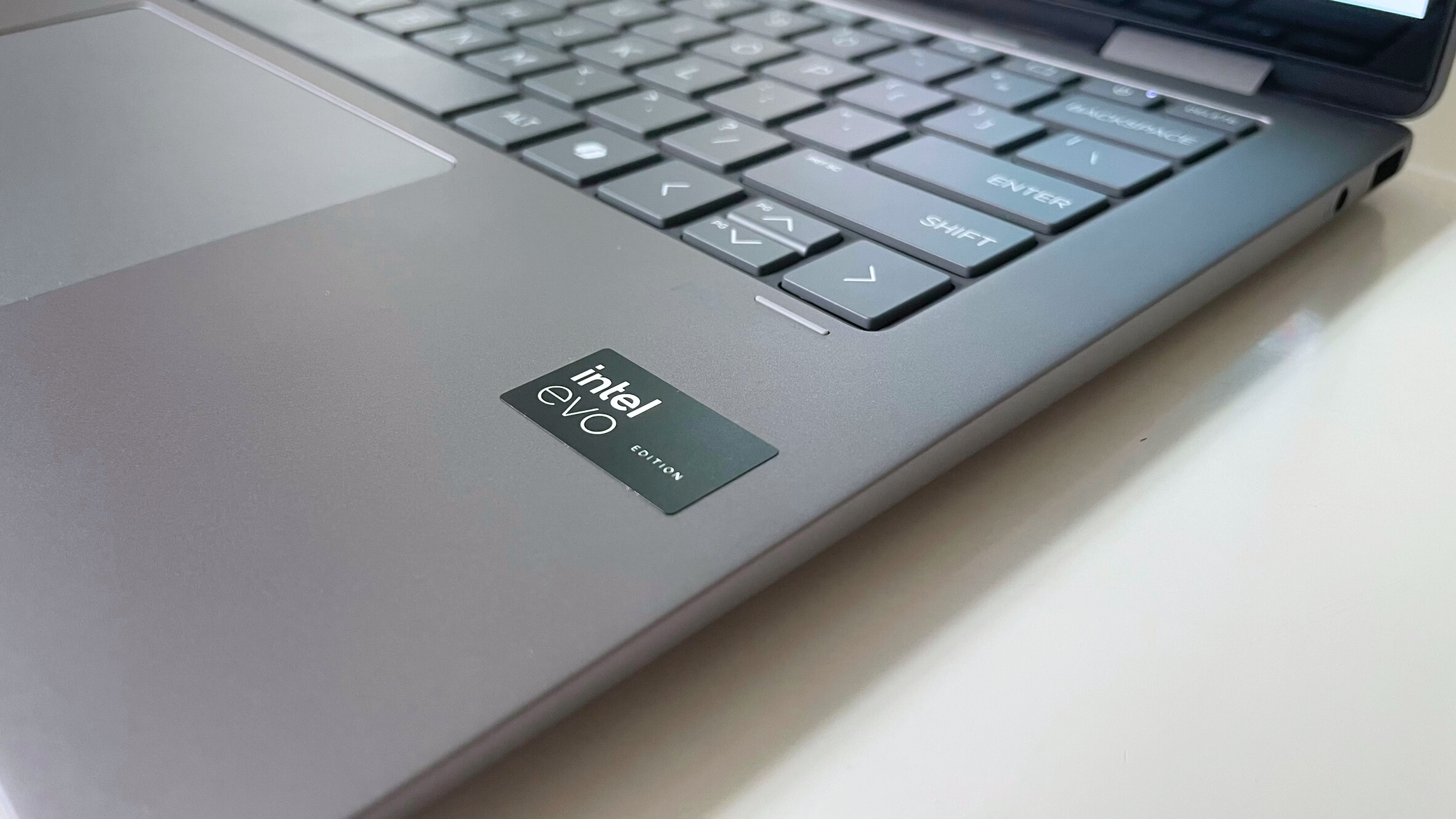
The HP Envy x360 2-in-1 struggled to keep up with comparable laptops in our overall performance benchmarks. It scored 2,305 on the Geekbench 6 single-core test, trailing the HP Spectre x360 14 by 50 points and falling behind the Lenovo Slim 7i by over 100 points. The HP Envy didn’t fare much better on the Geekbench 6 multi-core test, scoring 8,697. That’s over 3,000 points below the HP Spectre x360 14 and Lenovo Slim 7i and below our premium laptop average of 9,763.
In the HandBrake video transcoding test, the HP Envy took 11 minutes to convert a 4K video into 1080p, over double the time the Lenovo Slim 7i took to complete the same test. Considering that time, it’s not surprising the HP Envy also scored a lower file transfer speed of 901 MBps, far slower than the Lenovo Slim 7i’s score of 1,534 MBps and even the HP Spectre’s speed of 1,362 MBps.
These scores show that the HP Envy x360 2-in-1 has generally slower performance across the board than similarly priced mainstream laptops. The HandBrake and file transfer tests hint at slow SSD read/write speeds, which impact things like downloading files or loading games.
The low Geekbench scores are concerning since they indicate the level of performance you can expect in everything from gaming to web browsing. The HP Envy and Lenovo Slim 7i both have Intel Core Ultra 7 processors, which makes the gap between their scores a bit baffling. However, it may have something to do with the different variants of the Core Ultra 7 chip.
The HP Envy is equipped with the Intel Core Ultra 7 155U, while the Lenovo Slim 7i has the Intel Core Ultra 7 155H. That letter at the end makes a big difference. The Core Ultra 7 155H has 16 cores (including six performance cores) and 22 threads. In comparison, the Core Ultra 7 155U only has 12 core (including two performance cores) and 14 threads.
Those specs make a significant difference in performance, as the benchmark results show. So, while the HP Envy has an Intel Core Ultra CPU, HP opted for the lower-power variant of the Core Ultra 7, which is disappointing at this price point.
HP Envy x360 2-in-1: Battery life
The HP Envy x360 2-in-1 again fell short of our mainstream laptop average on our battery life test. It lasted 9 hours and 49 minutes, 14 minutes below our premium laptop average (10:03). That’s also 14 minutes behind the Lenovo Slim 7i Gen 9, which exactly matched the category average but over two hours behind the HP Spectre’s time (11:01).
The HP Envy’s battery life could be enough to get you through an 8-hour workday, but you will likely need to charge at some point unless you are only doing low-power tasks.
HP Envy x360 2-in-1: Webcam
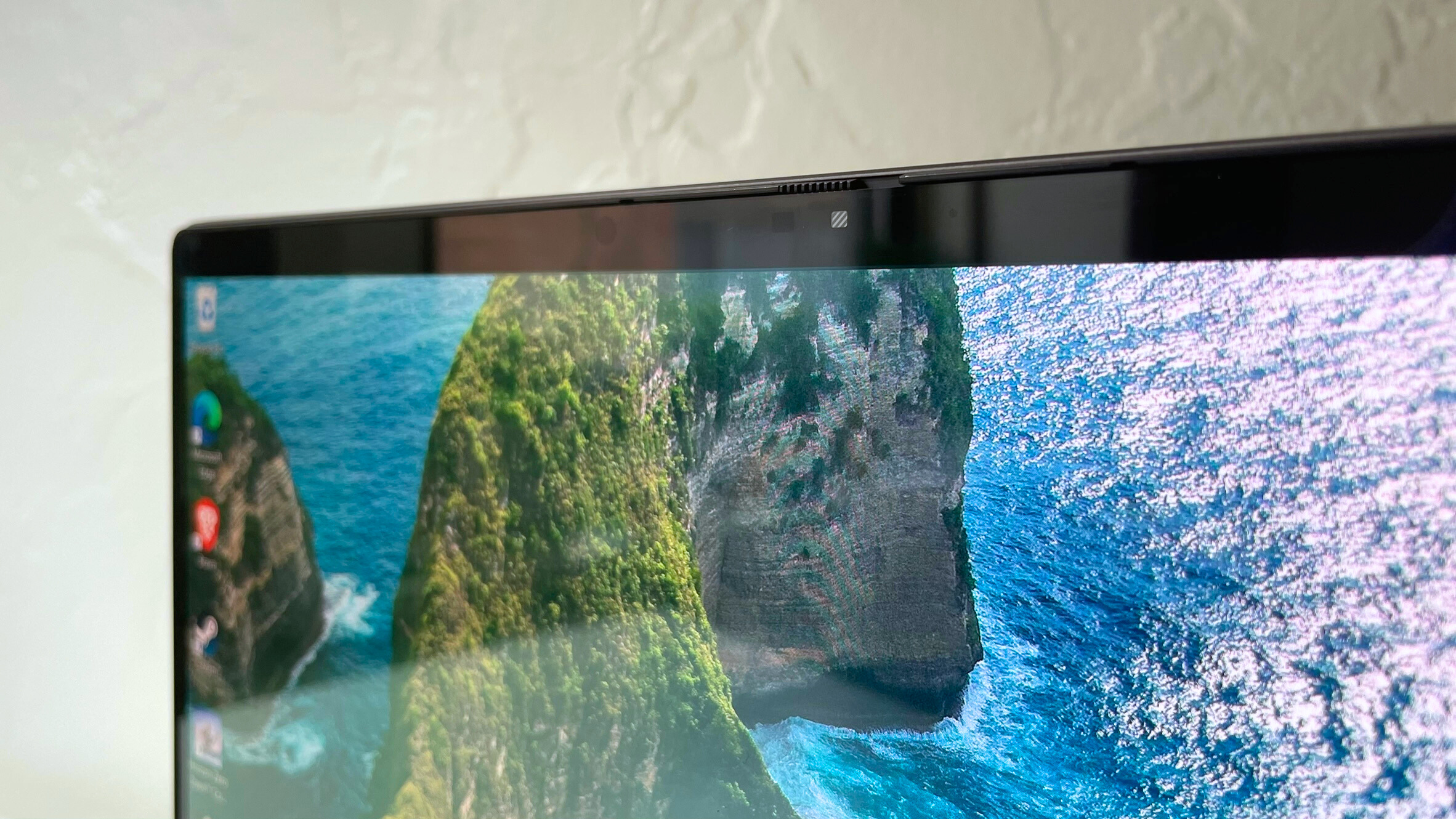
The HP Envy’s webcam is good enough for Zoom calls and video meetings. It’s an HP Wide Vision 5MP IR camera with a built-in privacy shutter, a feature I always like to see.
The webcam also supports the HP Enhanced Lighting app and Windows Studio Effects. HP Enhanced Lighting effectively creates a digital ring light using your screen, which you can adjust to improve your lighting. Windows Studio Effects uses AI for video effects like background blur and automatic framing.
The webcam quality looked fairly good in my test video. The image is a bit soft but isn’t outright grainy. The built-in mic also picked up my voice well (and did a decent job of cutting out the background noise from my air conditioner).
HP Envy x360 2-in-1: Heat
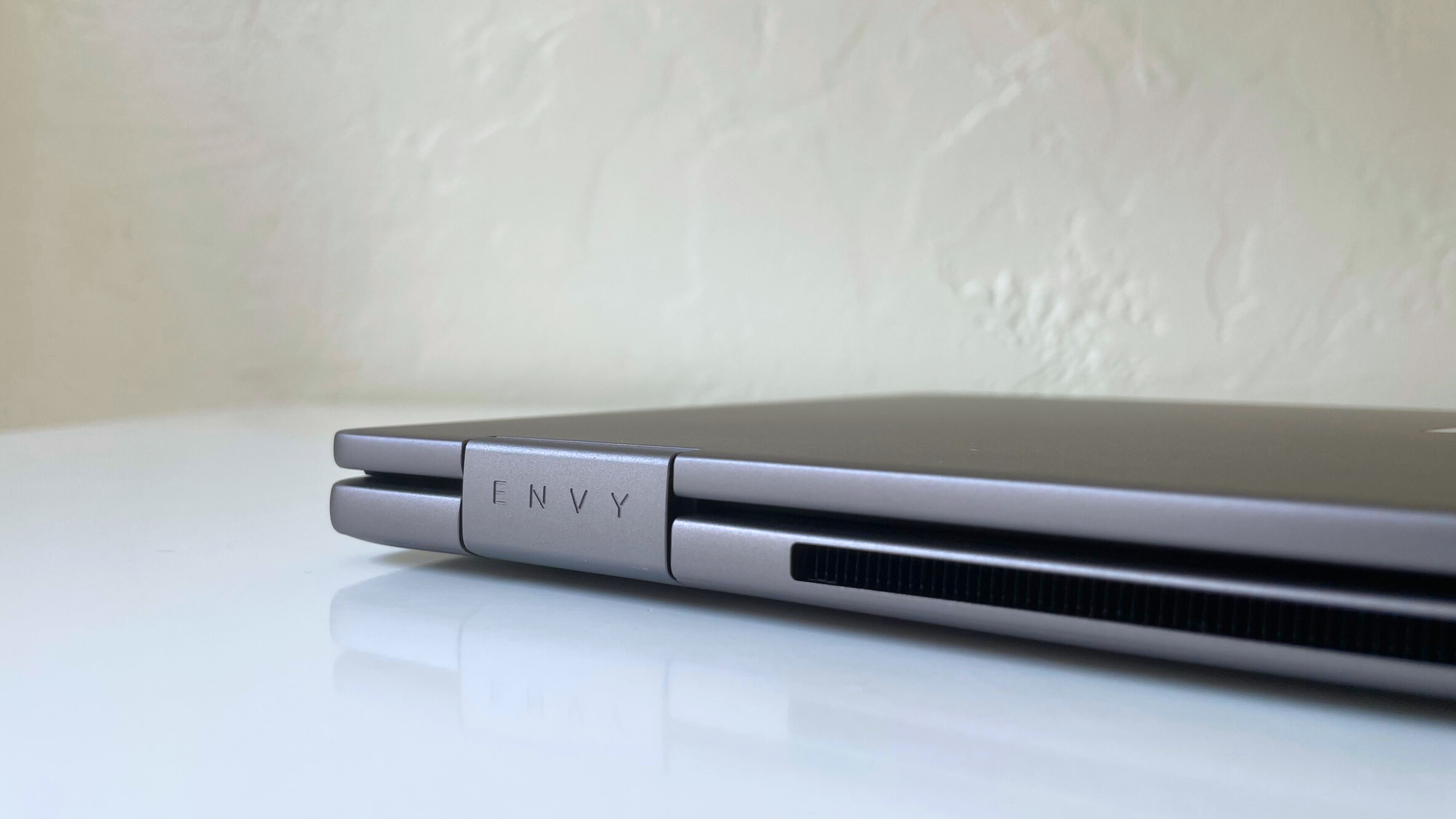
In our temperature tests, the HP Envy x360 2-in-1 averaged about 94 degrees, which is just below our 95-degree comfort threshold. The hottest temperature we recorded exceeded that, though, at 96 degrees in the upper left area of the keyboard deck around the R key.
The Envy stayed relatively cool during my testing, but I noticed it heating up while it was charging, downloading something, or running a game. Charging it and gaming simultaneously sent the temperature skyrocketing, as expected. When charging, it mainly heats up along the left edge of the keyboard deck (where the USB Type-C charging port is). The touchpad generally stayed nice and cool, averaging about 74 degrees.
HP Envy x360 2-in-1: Software and warranty
The HP Envy x360 2-in-1 includes a 1-year limited warranty for hardware support. If you want a longer or more comprehensive warranty for your device, HP offers optional protection plans you can select when configuring the HP Envy.
The Envy comes with Windows 11 Home by default, although you can upgrade to Windows 11 Pro for an additional $70. It includes the standard array of Windows such as Microsoft Edge, the Xbox app, and free versions of the Microsoft Office suite. The Envy also has the myHP app pre-installed, where you can find your warranty info and troubleshooting resources.
Bottom line
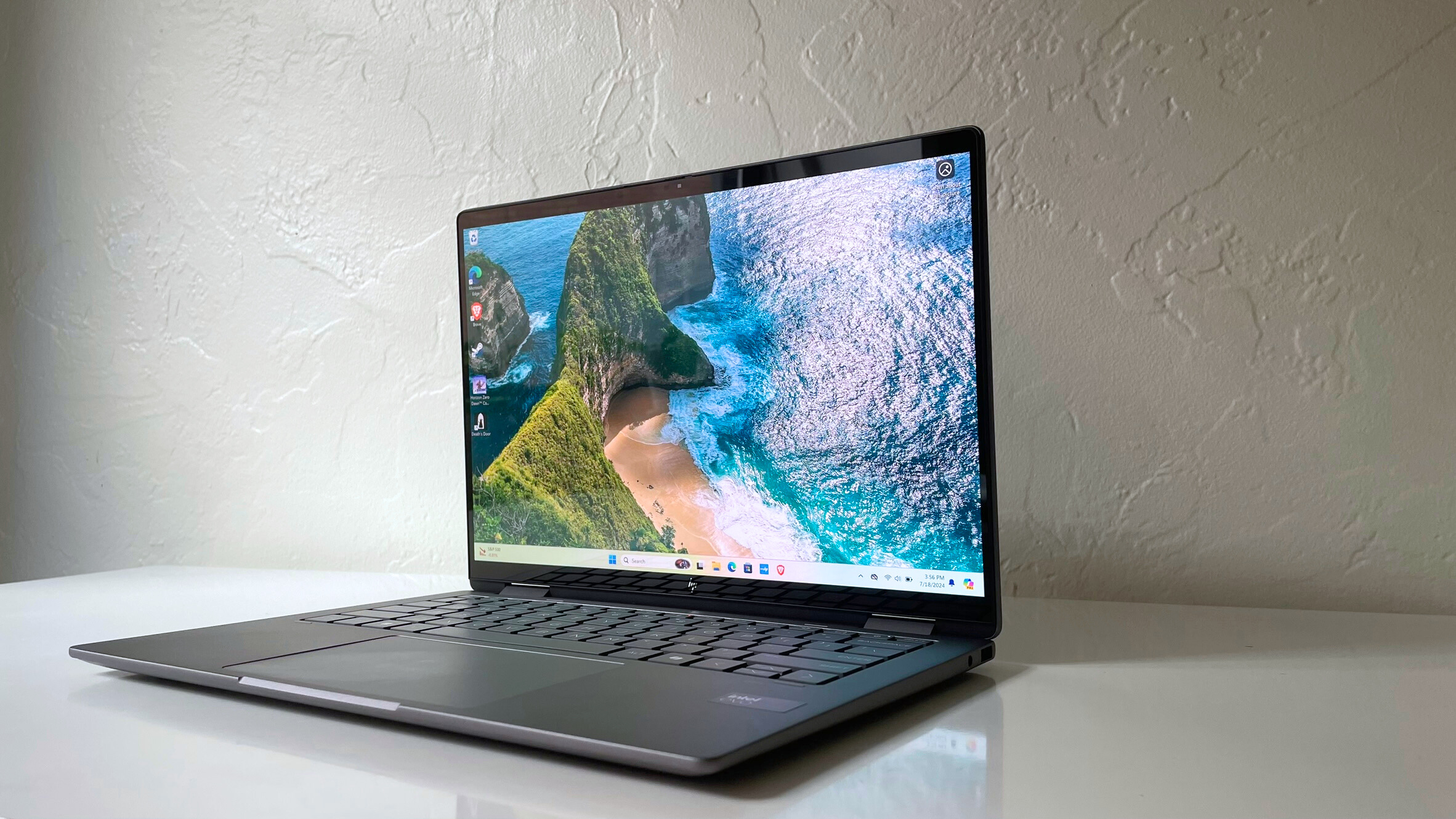
The HP Envy x360 2-in-1 sports a sleek design, solid speakers, and a vibrant OLED display, but the hardware powering all that falls short in key performance benchmarks. Especially considering the $1380 price tag on the Envy, other laptops in this price range can offer stronger performance, leaving the Envy overshadowed.
The HP Envy’s status as a 2-in-1 laptop helps it stand out but it still falls short of premium 2-in-1s like the HP Spectre x360 14. Considering the significant difference in performance, if you’re in the market for a 2-in-1 Windows laptop, it may be worth paying more for the HP Spectre. For even more recommendations, you can also visit our guide to the best 2-in-1 laptops.
The HP Envy x360 2-in-1 could be a good deal if it came at a lower price. It might be a good fit if you are only interested in the lowest spec versions or find it on sale. However, the full price for an OLED display, plenty of storage, and the Intel Core Ultra 7 155U processor simply doesn’t deliver as much power and performance as competitors in this price bracket.







